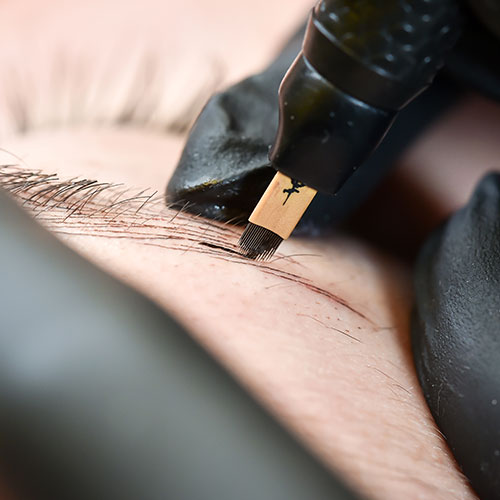Microblading is a cosmetic treatment that enhances eyebrows by applying semi-permanent pigment with fine strokes to resemble natural hairs.
Designed to enhance and define your eyebrows with precision and artistry.
Microblading Eyebrows: Everything You Need to Know
Microblading is a popular semi-permanent eyebrow treatment designed to create natural-looking, fuller brows. Using a hand-held tool with ultra-fine needles, pigment is manually deposited into the skin to mimic real eyebrow hairs. This technique is perfect for individuals with sparse, over-plucked, or uneven brows, as it offers precision, artistry, and customisation to suit each person’s unique facial structure and desired look.

Microblading: The Ultimate Guide to Flawless Eyebrows
Microblading is a popular semi-permanent eyebrow treatment designed to create natural-looking, fuller brows. Using a hand-held tool with ultra-fine needles, pigment is manually deposited into the skin to mimic real eyebrow hairs. This technique is perfect for individuals with sparse, over-plucked, or uneven brows, as it offers precision, artistry, and customisation to suit each person’s unique facial structure and desired look.
What is Microblading?
Microblading is a form of cosmetic tattooing, specifically designed for the eyebrows. The process involves creating hair-like strokes with pigment to replicate natural brow hairs, offering a more defined and fuller look. The pigment is carefully chosen to match your natural brow colour and is implanted into the top layers of the skin. Unlike traditional tattooing, the results are much softer and more natural-looking, with a focus on replicating the texture of real hair.
Who is Microblading Suitable For?
Microblading is an excellent option for anyone looking to enhance their eyebrow shape and fullness. It’s particularly suitable for individuals with sparse brows due to over-plucking, ageing, or naturally thin hair. It’s also ideal for those wanting to save time on their beauty routine, as microbladed brows eliminate the need for daily eyebrow makeup application.
The technique works well for most skin types, although it may fade faster on oily skin due to the higher production of natural oils. During your consultation, a professional technician will assess your skin type to ensure the best outcome for you.
The Microblading Process
Consultation: The process begins with a detailed consultation where the technician will discuss your desired brow shape, thickness, and colour. This step is crucial in ensuring the final look complements your face and personal style.
Brow Mapping: The technician will map out your brows using precise measuring tools to ensure symmetry and the most flattering shape for your face.
Microblading: Using a specialised hand-held tool with ultra-fine needles, the technician creates individual strokes to replicate the appearance of natural brow hairs. This process typically takes 2-3 hours, depending on the complexity of the design.
Aftercare: Post-procedure care is critical to ensure the pigment settles properly. You’ll be given specific instructions, including avoiding moisture, makeup, and direct sun exposure for the first week. The initial results will appear darker but will soften as the skin heals over the next 4-6 weeks.
Benefits of Microblading
- Natural Appearance: Microblading produces hair-like strokes that are almost indistinguishable from real hairs, giving a natural and fuller look.
- Time-Saving: Say goodbye to daily eyebrow makeup routines, as microbladed brows maintain their shape and definition for months.
- Long-Lasting: Results typically last between 12 and 18 months, depending on your skin type and aftercare. Occasional touch-ups are recommended to keep the brows looking fresh.
- Customisable: The shape, thickness, and colour of your brows can be tailored to suit your facial structure and personal preferences.
Healing and Maintenance
After the procedure, your brows will go through a healing process where the pigment may initially appear darker than expected. Over the next few weeks, the colour will soften and settle into its final shade. Most clients require a touch-up 6-8 weeks after the initial session to perfect the shape and colour.
To maintain the results, annual touch-ups are recommended, though some may find that they only need a touch-up every 18-24 months, depending on skin type and lifestyle factors such as sun exposure.
Is Microblading Painful?
Thanks to the application of numbing cream, most clients experience little to no discomfort during the procedure. Some may describe the sensation as a light scratching, but the treatment is generally well-tolerated.
Final Thoughts
Microblading offers a highly effective, semi-permanent solution for achieving perfectly shaped and fuller eyebrows. Whether you’re looking for a subtle enhancement or a dramatic transformation, microblading can be customised to meet your aesthetic goals. With long-lasting results and minimal maintenance, it’s no wonder that this technique has become one of the most sought-after treatments in the beauty industry.
If you’re ready to elevate your brow game with natural, beautifully defined brows, microblading might be the perfect solution for you.
FAQ
Microblading is a semi-permanent makeup technique that involves using a fine blade to deposit pigment into the skin, creating the appearance of fuller, more defined eyebrows. This method is particularly popular for those looking to enhance their natural brow shape or fill in sparse areas for a more polished look.
- Natural Appearance: Microblading creates hair-like strokes that mimic the natural look of eyebrow hairs, resulting in a soft and natural finish.
- Long-Lasting Results: The effects can last anywhere from 1 to 3 years, depending on skin type and aftercare.
- Time-Saving: Microblading eliminates the need for daily eyebrow makeup application, saving you time in your beauty routine.
- Customisable: The shape, colour, and thickness of your eyebrows can be tailored to suit your individual preferences and face shape.
The process begins with an initial consultation, where you and your technician will discuss your desired brow shape and colour. The technician will then map out your new brows to ensure symmetry and design. A topical numbing cream is applied to minimise discomfort, and the microblading procedure typically takes about 2 to 3 hours. After the procedure, you will receive aftercare instructions to ensure proper healing.
Most clients experience only mild discomfort during the procedure. Some describe the sensation as similar to light scratching. After the treatment, the area may be slightly tender but typically recovers quickly.
The healing process usually takes about 4 to 6 weeks. During this time, your eyebrows may appear darker initially, but the colour will soften and settle into a more natural shade as the skin heals.
- Proper aftercare is essential to achieve the best results. You should:
- Keep the treated area clean and avoid moisture for at least 10 days.
- Avoid heavy sweating, sun exposure, and swimming during the healing period.
- Refrain from applying makeup to the brow area until fully healed.
- Follow any specific aftercare instructions provided by your technician.
Microblading may not be suitable for individuals who:
- Are pregnant or breastfeeding.
- Have skin conditions such as eczema, psoriasis, or dermatitis in the brow area.
- Have a history of keloid scarring or other scarring issues.
- Are taking blood-thinning medications or have bleeding disorders.
- Suffer from autoimmune diseases or have a compromised immune system.
- Are currently undergoing chemotherapy or radiation treatment.
- Have sensitive skin or allergies to pigments.
It’s crucial to have a thorough consultation with your technician to discuss any health concerns and to determine if microblading is a suitable option for you.
Most clients will require a touch-up about 6 to 8 weeks after the initial procedure to perfect the shape and colour. After that, annual touch-ups may be necessary to maintain the desired look.
It is advisable to avoid applying makeup to the brow area until the skin has fully healed, which usually takes about 10 days. This helps to prevent infection and ensure the best results.
